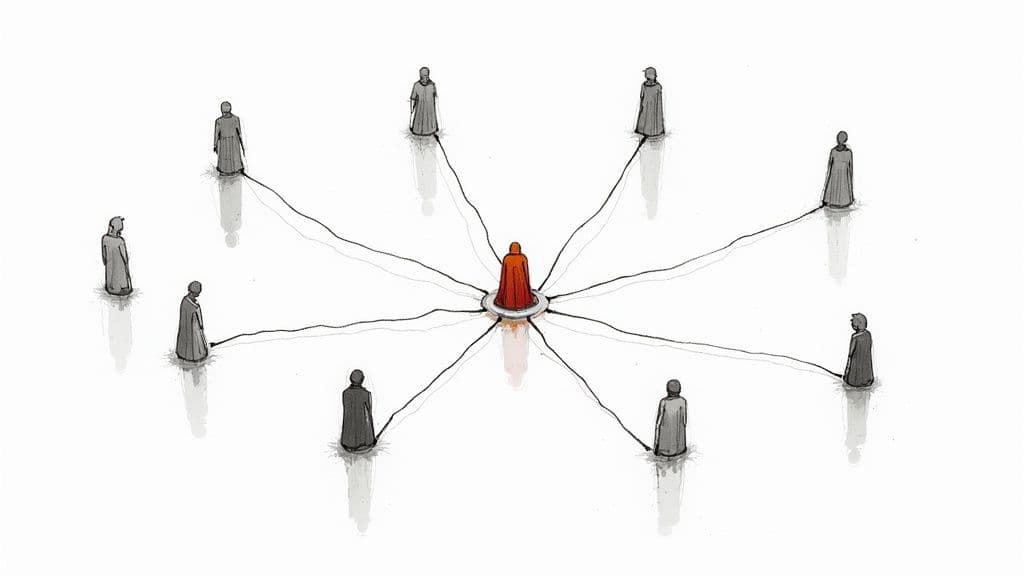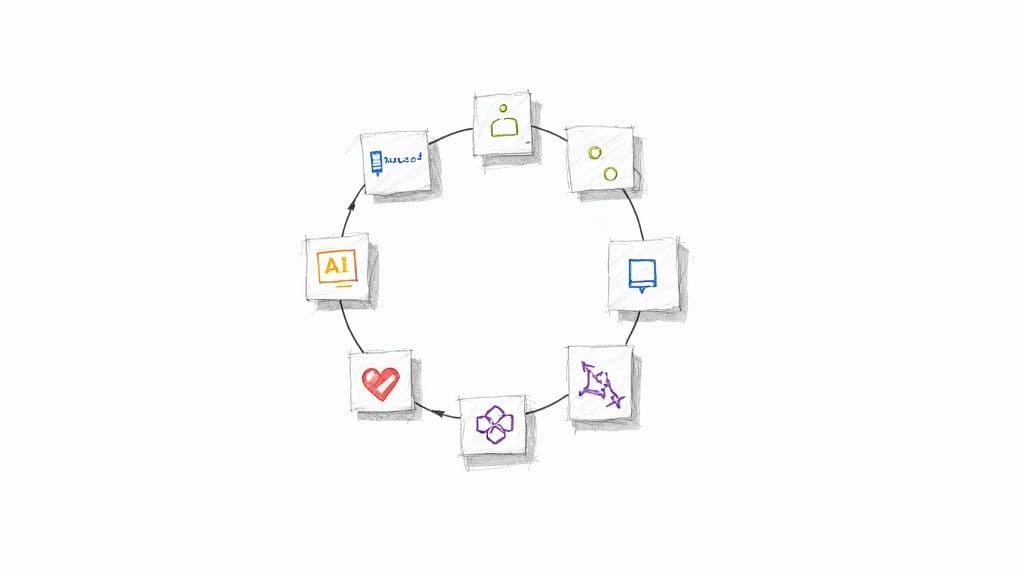In today's competitive landscape, acquiring new customers is only half the battle. The real key to sustainable growth lies in keeping the customers you already have. Effective customer retention optimisation is no longer a 'nice-to-have'; it's a critical business imperative that separates thriving businesses from those that merely survive. Retaining a customer is significantly more cost-effective than acquiring a new one, and loyal customers tend to spend more over time, making this a crucial focus for any subscription-based model.
This guide moves beyond generic advice, offering a deep dive into seven powerful, actionable strategies designed to boost subscriber loyalty and reduce churn. From hyper-personalisation and proactive success management to building vibrant brand communities, you will find practical steps to implement immediately. For those in education, many of these concepts parallel the insights found in guides on proven student retention strategies, as the core principles of engagement and value delivery are universal.
Each strategy is broken down into manageable actions, equipping you with the tools needed to fortify your customer relationships for long-term success. For creators on platforms like Telegram, a dedicated management tool can be instrumental in implementing these tactics, helping to automate subscriptions and provide the analytics needed to understand and engage your audience effectively. Let's explore how you can transform your customer base into a loyal community.
1. Personalized Customer Experience
A personalised customer experience moves beyond generic marketing to treat each subscriber as an individual. This strategy harnesses customer data, behavioural analytics, and AI to deliver tailored interactions, product recommendations, and communications. By understanding and anticipating individual needs, you transform a transactional relationship into a loyal, long-term connection, forming a cornerstone of effective customer retention optimisation.

00567297-d84d-4a92-9267-265c15886c8f.jpg
This approach is highly effective because it makes your members feel seen and valued. When a fitness app suggests a workout based on a user's previous sessions and stated goals, or a content creator sends a newsletter with links relevant to a subscriber's specific interests, it demonstrates a deep understanding of their preferences. This relevance drastically increases engagement and reinforces the value of their subscription.
How to Implement Personalisation
Begin by segmenting your audience based on shared characteristics like purchase history or engagement levels. From there, you can progress toward more granular, one-to-one personalisation.
- Data Transparency is Key: Always be clear about the data you collect and obtain explicit consent. A transparent policy builds trust, which is fundamental for long-term loyalty.
- Invest in a Unified View: Use a Customer Data Platform (CDP) to consolidate information from various touchpoints (website, app, social media) into a single, comprehensive profile for each customer.
- Test and Measure: Implement personalisation elements incrementally. A/B test personalised email subject lines, content recommendations, or special offers to measure their direct impact on engagement and churn rates.
- Balance Automation with Humanity: While AI and automation are powerful tools for scaling personalisation, don't underestimate the impact of a human touch. A personal check-in or a manually curated recommendation can have an outsized impact on high-value customers.
The success of this strategy is evident in platforms like Netflix, where personalised recommendations drive a staggering 80% of content watched. Similarly, Spotify’s "Discover Weekly" playlists have been credited with significantly boosting user engagement and stickiness. By making your service indispensable and uniquely attuned to each user, you create powerful barriers to churn.
2. Proactive Customer Success Management
Proactive Customer Success Management is a strategic approach that shifts the focus from reactive problem-solving to anticipating customer needs. Instead of waiting for a subscriber to encounter an issue or express dissatisfaction, this strategy involves actively guiding them towards achieving their desired outcomes with your service. This is a crucial element of customer retention optimisation because it directly links your product's use to the customer's success, making your service indispensable.

0032b306-2966-457d-b1bc-7a8315370f63.jpg
This method is powerful because it transforms the customer relationship from transactional to a partnership. For an online course instructor, this could mean checking in with students who haven't completed a key module. For a fitness coach, it might involve sending motivational messages to a member whose app usage has dropped. By demonstrating you are invested in their goals, you build deep-seated loyalty and significantly reduce the likelihood of churn. Proactive engagement ensures customers consistently realise the value of their subscription.
How to Implement Proactive Customer Success
Start by defining what "success" looks like for your customers and then build processes to guide them there. This involves monitoring engagement and intervening at critical moments throughout the customer lifecycle management.
- Implement Customer Health Scoring: Track key metrics like login frequency, feature usage, and content consumption to create a "health score" for each subscriber. This allows you to identify at-risk customers before they disengage.
- Develop Success Playbooks: Create standardised, repeatable actions for your team to take in common scenarios. For example, have a specific playbook for new member onboarding, another for low engagement, and one for celebrating customer milestones.
- Standardise Your Onboarding: A structured onboarding process with clear milestones is vital. Guide new subscribers through the essential steps needed to get their first "win" with your service as quickly as possible.
- Align Metrics with Outcomes: Ensure the metrics you track for customer success are directly tied to tangible business results like renewal rates, lifetime value, and reduced churn.
Gainsight's work with Marketo, which reportedly cut churn by 25%, showcases the financial impact of this strategy. Similarly, HubSpot's own customer success teams have used proactive outreach to great effect. By systematically ensuring your customers succeed, you build a sustainable model for long-term growth and loyalty.
3. Omnichannel Customer Experience
An omnichannel customer experience creates a seamless, integrated journey across all of your brand’s touchpoints. This strategy ensures consistency whether a subscriber interacts with you via your app, website, social media, or email. By unifying these channels, you allow customers to switch between them without friction, creating a single, continuous conversation and a powerful engine for customer retention optimisation.

6ed57414-1646-4130-b092-f5c5749deb6e.jpg
This approach is crucial because modern subscribers expect convenience and consistency. Imagine a member of your fitness programme watching a workout video on their laptop, then opening your mobile app to log their progress and ask a question via live chat. An omnichannel strategy ensures the data and context carry over, making the experience smooth and intuitive. This level of integration reinforces the value of your ecosystem and makes leaving for a less cohesive competitor far less attractive.
How to Implement an Omnichannel Experience
Building a true omnichannel environment begins with a deep understanding of how your customers interact with your brand across different platforms.
- Map the Customer Journey: Start by mapping out every possible touchpoint a subscriber has with your service. Identify where handoffs between channels occur and where friction points exist.
- Invest in a Central Data Hub: Use a Customer Data Platform (CDP) to create a unified view of each subscriber. This ensures that a user’s history and preferences are recognised across your mobile app, website, and email communications.
- Prioritise Key Touchpoints: You don't need to perfect every channel at once. Focus first on the most critical interactions for your subscribers, such as the transition from a social media ad to your sign-up page or from an email promotion to your app.
- Ensure Consistent Training: If you have a team interacting with customers, ensure they are trained on all platforms and have access to the same customer information. Consistency in service is just as important as consistency in technology.
Starbucks provides a masterclass in this, with its mobile app seamlessly connecting payments, rewards, and ordering for both in-store and online experiences. Similarly, Disney's MagicBand system integrates park access, hotel keys, and payments into one device. By removing barriers and creating a fluid, interconnected brand world, you make your service an indispensable part of your customer's routine.
4. Loyalty Program Optimisation
Loyalty program optimisation involves strategically designing and managing customer rewards to foster genuine, long-term commitment. It moves beyond simple point-based systems to create meaningful experiences that resonate with a member's values. This approach leverages emotional connection, personalised rewards, and exclusive benefits to make subscribers feel like valued insiders, turning a simple transaction into a deeper, more resilient relationship and forming a key pillar of customer retention optimisation.

708922e5-af1f-48f7-a05c-4715f447e9f2.jpg
This strategy is highly effective because it makes loyalty feel like a privilege, not just a discount scheme. When a fitness creator offers members early access to a new challenge, or a business coach provides an exclusive Q&A session for their most engaged subscribers, it builds a sense of community and exclusivity. These non-monetary rewards often create a stronger emotional bond than a simple percentage off, reinforcing the unique value of staying subscribed.
How to Implement Loyalty Program Optimisation
Start by understanding what your subscribers truly value beyond your core offering. A well-optimised program should feel like a natural extension of your brand, not an afterthought.
- Focus on Experiential Rewards: Go beyond discounts. Offer early access, exclusive content, behind-the-scenes looks, or personal shout-outs. These experiences are unique to your brand and harder for competitors to replicate.
- Create Clear, Achievable Tiers: Structure your program with tiers that offer increasingly valuable benefits. This gamifies the experience and gives members a clear incentive to deepen their engagement with your content or service.
- Ensure Simplicity and Ease of Use: A complicated program will not be used. Ensure the rules are straightforward, progress is easy to track, and rewards are simple to redeem, especially for digital-first audiences on platforms like Telegram.
- Regularly Survey Members: Your program must evolve with your members' needs. Use polls and surveys to ask what rewards they find most compelling and use that feedback to refine your offerings and maintain relevance.
The power of this approach is demonstrated by programs like Sephora's Beauty Insider, which uses a tiered system to offer exclusive experiences alongside product rewards. Similarly, Nike Membership integrates fitness tracking with exclusive product access, creating a holistic ecosystem that keeps members locked in. By making your loyalty program an indispensable part of the customer journey, you build powerful, lasting allegiance.
5. Voice of Customer (VoC) Programs
A Voice of Customer (VoC) program is a systematic strategy for collecting, analysing, and acting on customer feedback across every stage of their journey. This approach moves beyond occasional surveys to create a continuous, multi-channel dialogue with your subscribers. By using methods like interviews, social listening, and in-app feedback forms, you gain a deep understanding of customer needs, expectations, and pain points, which is essential for proactive customer retention optimisation.
This strategy is powerful because it shows subscribers you are actively listening and committed to improving their experience. When a course creator uses survey feedback to add a much-requested module, or a fitness app refines its user interface based on reviews, it demonstrates responsiveness. This validation turns passive users into active advocates, as they see their input directly shaping the service they pay for.
How to Implement a VoC Program
Start by identifying the most critical touchpoints in your customer journey and select the appropriate feedback tools for each. The goal is to make giving feedback effortless and integrated into the user experience.
- Use Multiple Feedback Channels: Don't rely solely on one method. Combine post-interaction surveys, social media monitoring, and direct interviews to build a comprehensive picture of customer sentiment.
- Close the Feedback Loop: This is the most crucial step. Always communicate back to your customers about the changes you've made based on their feedback. This reinforces the value of their contribution and builds immense trust.
- Segment Your Feedback: Analyse feedback based on customer segments, such as new subscribers versus long-term members, or high-engagement users versus those at risk of churn. This helps prioritise improvements that will have the biggest impact.
- Empower Your Team: Train your staff on how to properly collect, interpret, and respond to feedback. Set up automated alerts for critical issues, such as a sudden spike in negative comments, to enable a rapid response.
The success of VoC is clear in examples like Airbnb, which continuously refines its platform for both hosts and guests based on their feedback systems. Similarly, Uber’s two-way rating system is a real-time VoC program that directly influences service quality and user safety. By embedding the customer’s voice into your operational DNA, you make your service more resilient and aligned with user needs, creating a powerful defence against churn.
6. Predictive Churn Analytics
Predictive churn analytics is a data-driven strategy that leverages machine learning and statistical models to identify subscribers likely to cancel their membership before they actually do. This approach analyses historical and real-time customer data, including engagement patterns, usage frequency, and support interactions, to calculate a "churn risk" score for each individual. By forecasting potential churn, you can shift from a reactive to a proactive stance in your customer retention optimisation efforts, allowing for targeted, timely interventions.
This method is powerful because it allows you to allocate your resources efficiently, focusing on at-risk members who are most valuable. For a fitness coach, this might mean identifying a client whose app logins have dropped and offering a complimentary one-to-one session. For an online course creator, it could involve sending encouraging content or a personalised check-in to a student who hasn't completed a module in weeks. This foresight is crucial for preventing customer loss before it happens.
How to Implement Predictive Churn Analytics
Start by gathering clean, comprehensive data, as the quality of your predictions depends entirely on the quality of your inputs. Focus on creating actionable models rather than striving for perfect accuracy.
- Combine Diverse Data Sources: Integrate behavioural data (e.g., login frequency, feature usage) with transactional data (e.g., subscription plan, payment history) and demographic information for a holistic view of each subscriber.
- Establish Clear Intervention Processes: Create a clear plan for what happens when a member is flagged as high-risk. This could trigger an automated email sequence, a notification for a community manager, or a special offer.
- Test and Refine Interventions: Not all at-risk segments will respond to the same strategy. A/B test different retention tactics, such as discounts versus exclusive content, to see what works best for different groups.
- Regularly Retrain Your Models: Customer behaviour evolves, so your predictive models must too. Continuously feed them new data to ensure their accuracy and relevance remain high over time. By taking these steps, you can significantly improve your ability to reduce churn rate.
Companies like Verizon have successfully used predictive analytics to reduce churn by as much as 15% by identifying at-risk customers early. Similarly, SaaS platforms such as HubSpot have seen retention improvements by proactively engaging users their models predict are likely to leave. This proactive approach turns data into a powerful tool for safeguarding your revenue and fostering long-term loyalty.
7. Customer Community Building
A strategic approach to customer retention optimisation involves creating and nurturing spaces where customers can connect with each other, share experiences, and engage directly with your brand. This strategy transforms one-to-one customer relationships into a vibrant, many-to-many network. By fostering peer-to-peer connections and a shared identity around your brand, you build a powerful sense of belonging that significantly enhances loyalty and reduces churn.
This method is incredibly effective because it gives your members a reason to stay that goes beyond your core product or service. When a fitness enthusiast in a Peloton group finds an accountability partner, or a course creator gets valuable feedback from fellow users in a dedicated forum, the community itself becomes an indispensable feature. This shared space creates deep-seated loyalty, making your brand a central part of your members' identity.
How to Implement Customer Community Building
Start by defining the purpose of your community and establishing clear guidelines. From there, focus on creating an environment that encourages active and meaningful participation.
- Establish Clear Guidelines: Create and enforce community rules to ensure a safe, positive, and constructive environment. Active moderation is crucial, especially in the early stages, to set the right tone.
- Provide Exclusive Value: Drive initial participation by offering community-exclusive content, early access to new features, or direct Q&A sessions with experts or your team. This makes membership feel privileged and worthwhile.
- Recognise and Reward Superusers: Identify and celebrate your most active members. A simple shout-out, a special badge, or a small gift can motivate them to continue contributing and inspire others to participate.
- Encourage User-Generated Content: Launch contests, challenges, or prompts that encourage members to share their own experiences, tips, and successes. This not only boosts engagement but also provides authentic social proof. To learn more, explore these actionable strategies to build an online community on mymembers.io.
The success of this strategy is powerfully demonstrated by brands like Sephora, whose Beauty Insider Community allows members to exchange advice and tutorials, and Salesforce, whose Trailblazer Community connects users for professional development. By creating a hub for connection and mutual support, you make your brand an integral part of your customers' lives, a key pillar of long-term customer retention optimisation.
7 Key Strategies Comparison
| Strategy | Implementation Complexity 🔄 | Resource Requirements ⚡ | Expected Outcomes 📊 | Ideal Use Cases 💡 | Key Advantages ⭐ |
|---|---|---|---|---|---|
| Personalized Customer Experience | High: complex AI & data systems | High: technology, data infrastructure | Increased engagement, conversion, CLV | E-commerce, subscription services, retail | Tailored experiences, higher conversions |
| Proactive Customer Success Management | Medium-High: staff & training intensive | Medium-High: specialized staff, tools | Reduced churn, improved satisfaction & loyalty | SaaS, B2B, subscription models | Prevents churn, stronger customer relations |
| Omnichannel Customer Experience | High: technology integration across platforms | High: multi-channel systems, training | Consistent experience, higher retention | Retail, hospitality, large enterprises | Seamless channel switching, operational efficiency |
| Loyalty Program Optimization | Medium: program design & management | Medium: marketing, rewards budget | Increased retention, higher spend | Retail, hospitality, subscription services | Emotional connection, targeted marketing |
| Voice of Customer (VoC) Programs | Medium: feedback systems & analytics | Medium-High: surveys, analytics tools | Data-driven decisions, improved satisfaction | All industries focusing on CX improvement | Direct insights, closed-loop feedback |
| Predictive Churn Analytics | High: advanced machine learning models | High: data science talent, infrastructure | Proactive retention, cost reduction | Subscription, SaaS, telecom, finance | Early churn detection, optimized retention |
| Customer Community Building | Medium-High: platform & moderation | Medium-High: community management | Strong loyalty, peer support, user-generated content | Brands seeking engagement and advocacy | Emotional connections, support cost reduction |
Unlocking Sustainable Growth Through Retention
Navigating the landscape of customer retention can feel complex, but the path to loyalty is paved with consistent, deliberate actions. Throughout this guide, we have explored a powerful toolkit of strategies designed to transform your approach from reactive problem-solving to proactive relationship-building. From leveraging the granular insights of predictive churn analytics to crafting deeply personalised customer experiences, each tactic serves a singular purpose: to make your customers feel seen, understood, and valued.
Mastering customer retention optimisation is not about implementing every strategy at once. It is about understanding that these elements, whether it's building a vibrant customer community or implementing a structured Voice of the Customer (VoC) program, are interconnected. A well-designed loyalty program is more effective when informed by customer feedback, and proactive success management becomes seamless when supported by omnichannel communication. The core principle that unites them all is a fundamental shift in perspective: viewing retention as the engine of sustainable growth, not just a defensive measure against churn.
From Theory to Action: Your Next Steps
The true value of these insights lies in their application. To move from knowledge to results, consider this actionable roadmap:
- Start Small, Aim High: Don't feel overwhelmed. Select one or two strategies that align most closely with your immediate business challenges. Is feedback your biggest blind spot? Start with a simple VoC survey. Are you seeing drop-offs at a specific point? Focus on proactive outreach for that segment.
- Establish Your Baseline: Before you begin, measure your current retention and churn rates. This baseline is critical. Without it, you cannot accurately gauge the impact of your new initiatives. Track key metrics like Customer Lifetime Value (CLV), churn rate, and Net Promoter Score (NPS).
- Integrate and Automate: True efficiency is found when these strategies become part of your operational DNA. This means integrating them into a cohesive system. For creators and small businesses, this is where technology becomes an indispensable ally, automating the manual tasks that consume valuable time.
Ultimately, effective customer retention optimisation is a continuous journey of listening, adapting, and improving. It’s about building a business culture that is genuinely customer-centric. By consistently delivering undeniable value and fostering genuine connections, you move beyond simple transactions. You begin to cultivate a loyal base of advocates who not only stay with you but also champion your brand, fuelling a powerful cycle of organic, long-term growth. The path to reduced churn and increased loyalty begins today, with your first deliberate step towards better serving your customers.
Ready to automate the administrative side of retention and focus on building your community? MyMembers seamlessly manages your Telegram subscriptions, payments, and member access, freeing you to implement the powerful strategies discussed here. Discover how MyMembers can supercharge your customer retention efforts today.
